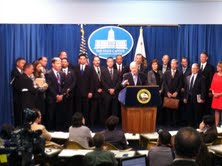 Citing a lack of civil rights and social inequities as what is wrong with California public schools, Gov. Jerry Brown vowed Wednesday at a Capitol press conference to give more money to the K-12 school districts that serve poorer students and English-language learners.
Citing a lack of civil rights and social inequities as what is wrong with California public schools, Gov. Jerry Brown vowed Wednesday at a Capitol press conference to give more money to the K-12 school districts that serve poorer students and English-language learners.
Brown said state funding needs to balance social equity and restore school funding cuts; and provide supplemental funding to children in high-poverty schools.
Following passage of Proposition 30 last November, raising taxes $6 billion, Brown’s controversial plan to shift money from wealthier schools to poor ones is a result of an emboldened Democratic supermajority.
Lawmakers and the governor are clearly preparing for the state’s looming June 15 budget deadline, with Brown working hard to get his proposal passed. Earlier this week, state Senate Democrats announced they had their own education funding proposal, but it involves significantly less state funding. However, both plans call for a large redistribution of state funding from middle class and wealthier schools to schools which serve poorer, non-English speaking immigrant students.
The Senate’s proposal requires a one-year wait before implementation. But Brown and the Superintendents with him at the press conference said they supported making the funding immediate.
Brown’s plan
“Under Brown’s formula, all students would receive a base grant that restores most of the money that districts have lost since 2007-08,” education journalist John Fensterwald recently explained at EdSource. “In addition, districts would receive an additional 35 percent — about $2,375 – for every English learner or low-income child. The concentration grant would be phased in on top of that. For districts with only high-needs students, it would provide an extra 18 percent: $1,120 per child — a significant boost for urban districts like Fresno, Santa Ana and Long Beach.”
However, both plans from Democrats would insure that all school districts have spending levels fully restored.
“The level of inequity hasn’t gotten better, it’s gotten worse,” Brown said. But he neglected to acknowledge that this inequity has grown under Democratic control of the state. Instead, Brown said the way to diminish the increasing socioeconomic gap between the poor and the wealthy in California is to funnel even more funding to schools with English-language learners and poorer students.
The governor’s proposal would primarily benefit urban and rural districts in economically poor areas. Wealthier suburban schools would not benefit from his proposal.
“The formula, as proposed, looks at struggle and peril,” Brown said.
Superintendents behind Brown’s proposal
School superintendents from public school districts throughout the state joined the governor at the press conference.
“Without this, we’re not going to have every student accessing this thing we call ‘the American Dream,’” Superintendent John Deasy from the Los Angeles Unified School District said. “To delay this funding formula is intolerable. Equity delayed is equity denied.”
Sacramento City Unified School district Superintendent Jonathan Raymond echoed Deasy’s comments, “Not to do this is immoral and criminal.”
Raymond lauded Brown’s proposal and said that, despite the state’s challenges, this is the moment to fix poverty in schools.
“I have three words for you to take away,” said Mary Jane Burke, Marin County Superintendent of Schools. “Flexible, accountability, equity, and local control.” Oops. “Well, four words,” she added, missing the fifth word. “It’s not good enough for a wealthy child to be successful.”
But others say any additional school funding should be shared equally by all school districts, and only then should extra money be used to target disadvantaged students.
The Brown reform also doesn’t address the problem of overall school reform, in particular getting rid of abusive and incompetent teachers that remain protected by the teachers unions. Shifting money from suburban schools to poor schools won’t help if the taxpayers’ dollars only go to improve the decor in the “rubber rooms” where bad teachers are parked — while drawing full pay, benefits and pensions points.
Brown’s cause
“This is a cause,” Brown said. “60 percent of kids going to school in California are poor, or speak a language other than English.”
“I’m going to do everything I can to see this bill passes this year,” he added, “Increasingly, this state is turning into a two-tier society. Those at the top are doing better and better and those in the middle and the bottom are doing worse and worse. The very least that we can do is invest in our schools in a way that recognizes reality.”
The redistribution
Brown said his proposal to overhaul California’s school financing formula and to shift more money to poor and English-learning students is a matter of “civil rights.” He promised to give opponents “the battle of their lives.”
“This is a matter of equity and civil rights,” Brown said. “So if people are going to fight it, they’re going to get the battle of their lives, because I’m not going to give up until the last hour, and I’m going to fight with everything I have, and whatever we have to bring to bear in this battle, we’re bringing it.”
Brown said today the measure is “not an ordinary legislative matter,” but ” a cause for the children of California. This is about the issue of what California needs to be equitable, and the Democratic Party is about equity.”
Brown was asked if he is open to renegotiating the base amount paid to all students. “We have different kinds of families,” Brown said. “We politicians usually deal with upper. But I want to help these kids. The facts of life in California are deep inequities. We’re dealing with the facts of life.”

